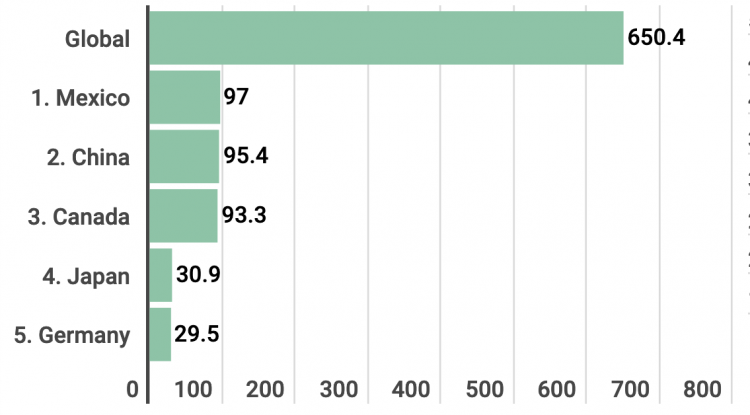 TREND: In February, Mexico became the US’s largest trade partner again, surpassing China by US $1.6 billion due to a significant contraction of Chinese imports and exports this month. Between January and February 2021, US exports to China contracted 26.83 percent. US imports from China contracted 12.99 percent which led to a total US-China trade contraction of 0.9 percentage points from 15.6 percent to 14.7 percent. This trend is similar to other years where Chinese trade contracts between January and February. Mexico and Canada’s percent of total trade grew by 0.3 percentage points and 0.5 percentage points, respectively. However, Mexican total bilateral trade with the US was 0.10 percent lower than February 2020 and 5.55 percent lower than January 2021. US exports to Mexico grew this month at a pace not seen in the last ten years while US imports from Mexico contracted.
TREND: In February, Mexico became the US’s largest trade partner again, surpassing China by US $1.6 billion due to a significant contraction of Chinese imports and exports this month. Between January and February 2021, US exports to China contracted 26.83 percent. US imports from China contracted 12.99 percent which led to a total US-China trade contraction of 0.9 percentage points from 15.6 percent to 14.7 percent. This trend is similar to other years where Chinese trade contracts between January and February. Mexico and Canada’s percent of total trade grew by 0.3 percentage points and 0.5 percentage points, respectively. However, Mexican total bilateral trade with the US was 0.10 percent lower than February 2020 and 5.55 percent lower than January 2021. US exports to Mexico grew this month at a pace not seen in the last ten years while US imports from Mexico contracted.
• Mexico’s bilateral trade flows with the US have maintained a steady course as total trade changed only by 0.10 percent compared to same month last year while China’s plummeted. US imports from Mexico suffered a minor slump while US exports to Mexico saw a historic rise of 8.02 percent between January and February not seen over the previous ten years.
Top 5 US trade partners (as of February 2021)
Click here for AmCham’s Trade Dashboard English – Spanish

• Total US-Mexico bilateral trade is expected to grow significantly over the next three months -compared to last year-, as business contracted by more than 50 percent between March and May of 2020.
• As of this month, Mexico is the top trade partner of the US. Total US-Mexico trade in 2021 equals US $97 billion or 14.9 percent of total US trade, which is now greater than China ($95.47 billion) and Canada ($93.3 billion). Mexico trade represented a 14.6 percent share of total US trade in January 2021. In February 2021, only Mexico changed its position in the top 5 US trade partners ranking: 1. Mexico, 2. China, 3. Canada, 4. Japan, and 5. Germany.
• As of February 2021, Mexico continued to grow its participation as a top export destination for US products compared to January 2020 from 15.3 percent to 16.1 percent share of total US exports. However, Mexico is still behind Canada, which also grew (from 16.6 percent – 17.3 percent) but ahead of China, which contracted (10.1 percent – 8.8 percent). Last year, Canada closed the year with 17.8 percent and China with an 8.7 percent share of total US exports. Canada’s percent of total exports are looking more similar to last year as they recover from the minor contraction in January 2021.
• US imports from China decreased significantly in February, which helped Mexico recover as the US’ largest trade partner. China is still the top source of US imports (18.3 percent of total), followed by Mexico (14.2 percent) and Canada (12 percent). However, its market share contracted significantly from 19.1 percent last month. In 2020, China closed the year as the top source of US imports (18.6 percent of total), followed by Mexico (13.9 percent) and Canada (11.6 percent).
• In February 2021, most US imports from Mexico contracted compared to January 2021; however, the three categories that grew the most were: (i) Footwear and headgear (34.57 percent), (ii) Animal and vegetable fats, oil, and waxes (19.45 percent), and live animals and animals products (19.16 percent). The top 5 US imports from Mexico with the most growth this year compared to 2020 are still the same: (i) fertilizers, (ii) albuminoidal subst; modified starch; glue enzymes, (iii) food industry residues & waste, prep animal feed (iv) silk, including yarns and woven fabric, and (v) cotton, including yarn and woven fabric.
• During the same period, US exports to Mexico contracted marginally in most sectors but the rise was concentrated in a few sectors compared to January 2021. The three sectors that grew the most in this period were: (i) mineral products (107.92 percent), and (ii) arms and ammunition (45.57 percent), and (iii) work of art and antiques (33.48 percent). The top 5 US exports to Mexico that grew the most compared to 2020 were (i) fur skins and artificial fur, (ii) lac; gums, resins & other vegetable sap and extract, (iii) apparel articles and accessories, not knit, (iv) mfr of straw, esparto, etc.; basket ware and wickerwork, and (v) live animals.
TAKEAWAY: Mexico is again the US’ top trade partner. US-Mexico bilateral trade contracted by less than 0.5 percent compared to January 2021. However, Mexico performed better than China, which lost market share this month. US exports to Mexico saw historic growth while US imports from Mexico contracted marginally. Mexico’s rise as the US’s top trade partner was the direct consequence of China’s contraction, and its continuance will be affected mainly by US-China trade performance. Starting next month we project that US-Mexico trade will start to grow compared to last year as the US’ vaccination policy starts to accelerate to include most adults. The impact of the pandemic on previous years’ trade starts to take effect. Mexico will continue to be favored by rising US-China trade tensions as a strong alternative for nearshoring operations and create supply chain alternatives for companies that are currently importing products for the US market from Asia.
* Spotlight by José Burnes, AmCham/Mexico’s Trade & Investment Center Manager and Gaby Valdés, Trade & Investment Center Specialist. The American Chamber of Commerce of Mexico (AmCham/Mexico) seeks to facilitate commercial integration between Mexico and the US, build a favorable business environment, and contribute with proposals to consolidate Mexico’s competitiveness and development as a top destination for American investment. By connecting companies and sharing trends and market intelligence, its Trade & Investment Center boosts cross-border business. Twitter: @amchammexico


